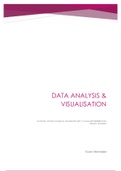Samenvatting
Data Analysis and Visualisation Summary
- Instelling
- Universiteit Utrecht (UU)
This is a summary of the Data Analysis and Visualisation course taught at Utrecht University as part of the Applied Data Science (ADS) profile. Its contents are an extensive yet comprehensive summary of all chapters of the book Introduction to Statistical Learning (James et al.) and relevant papers...
[Meer zien]





